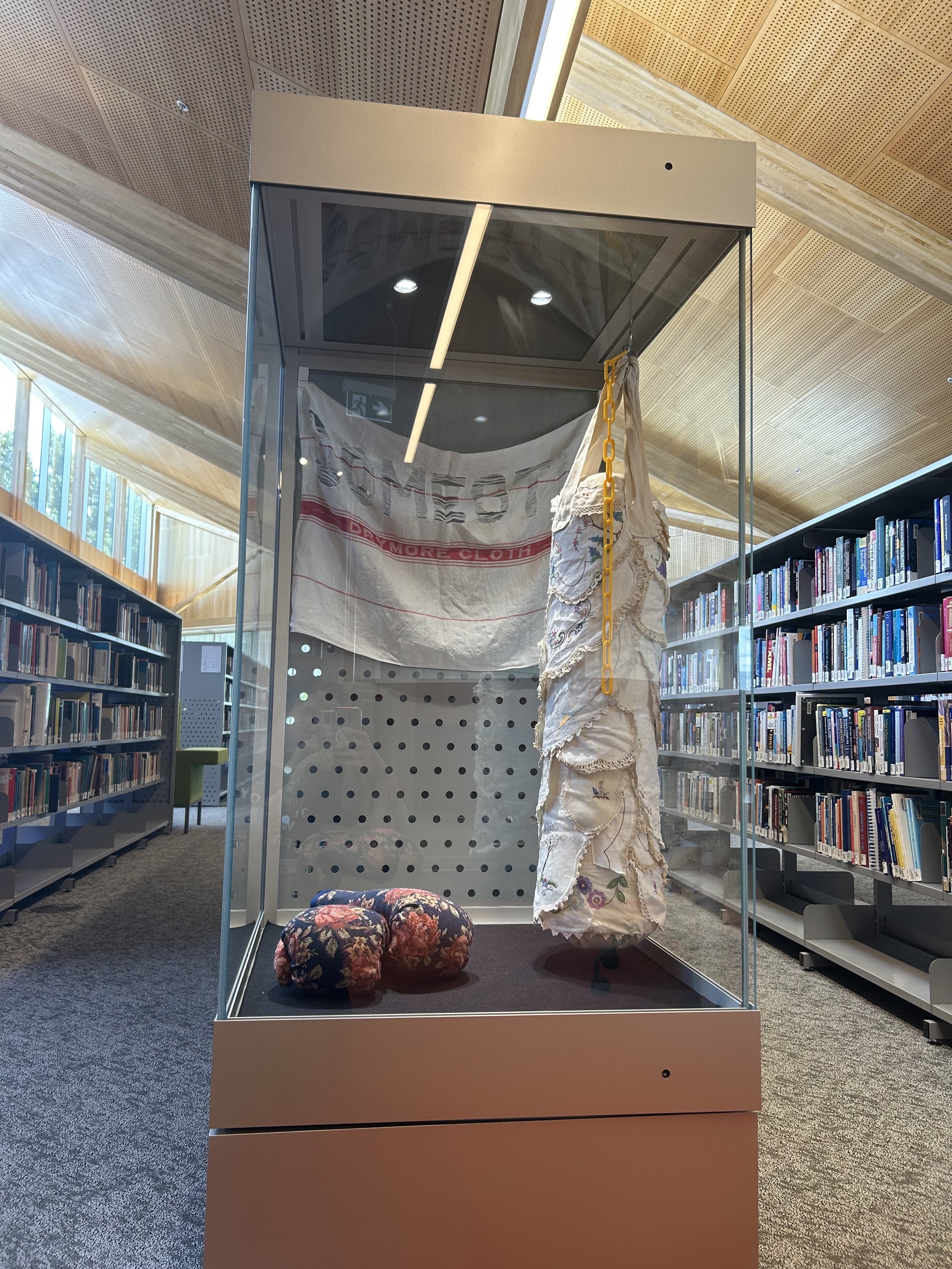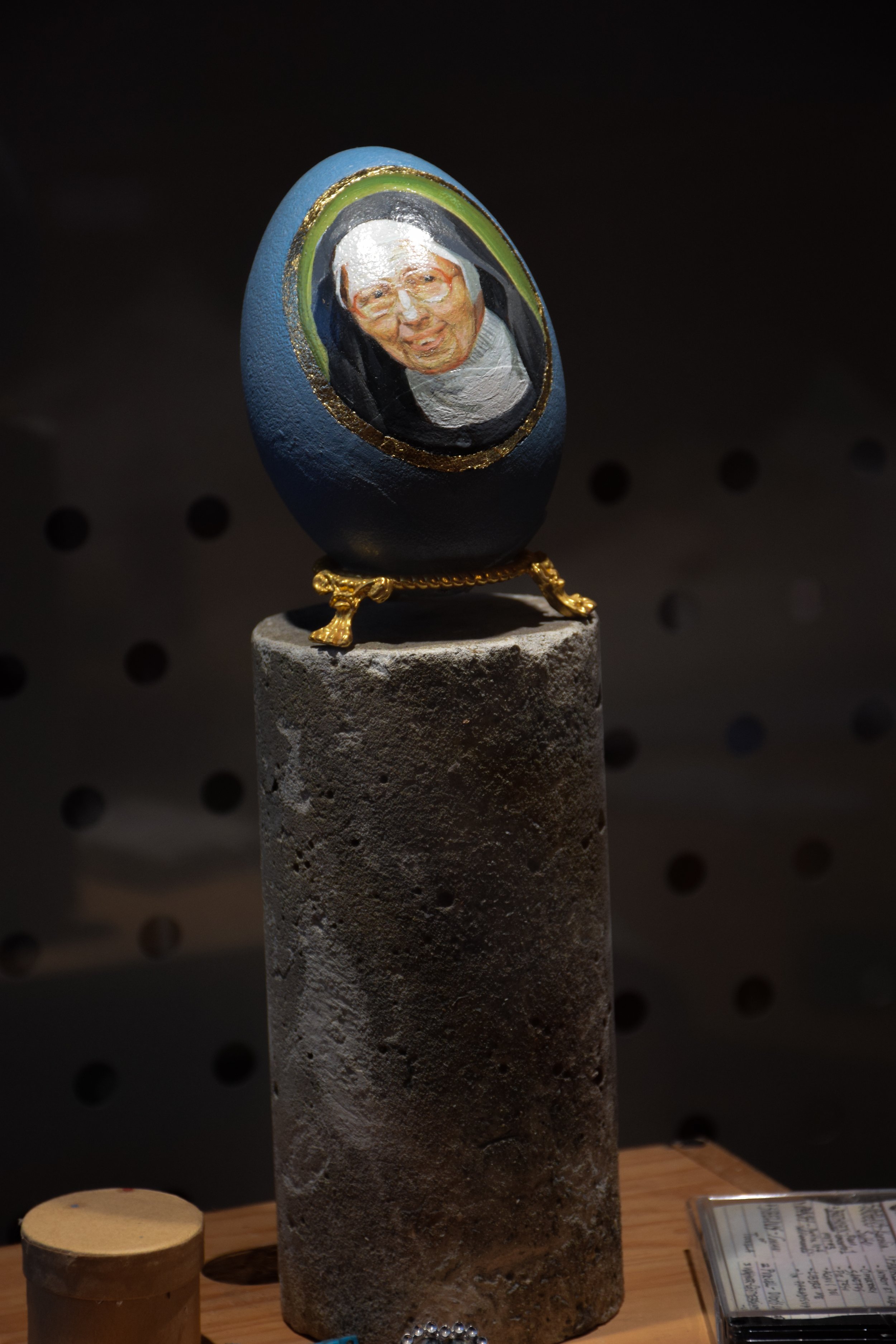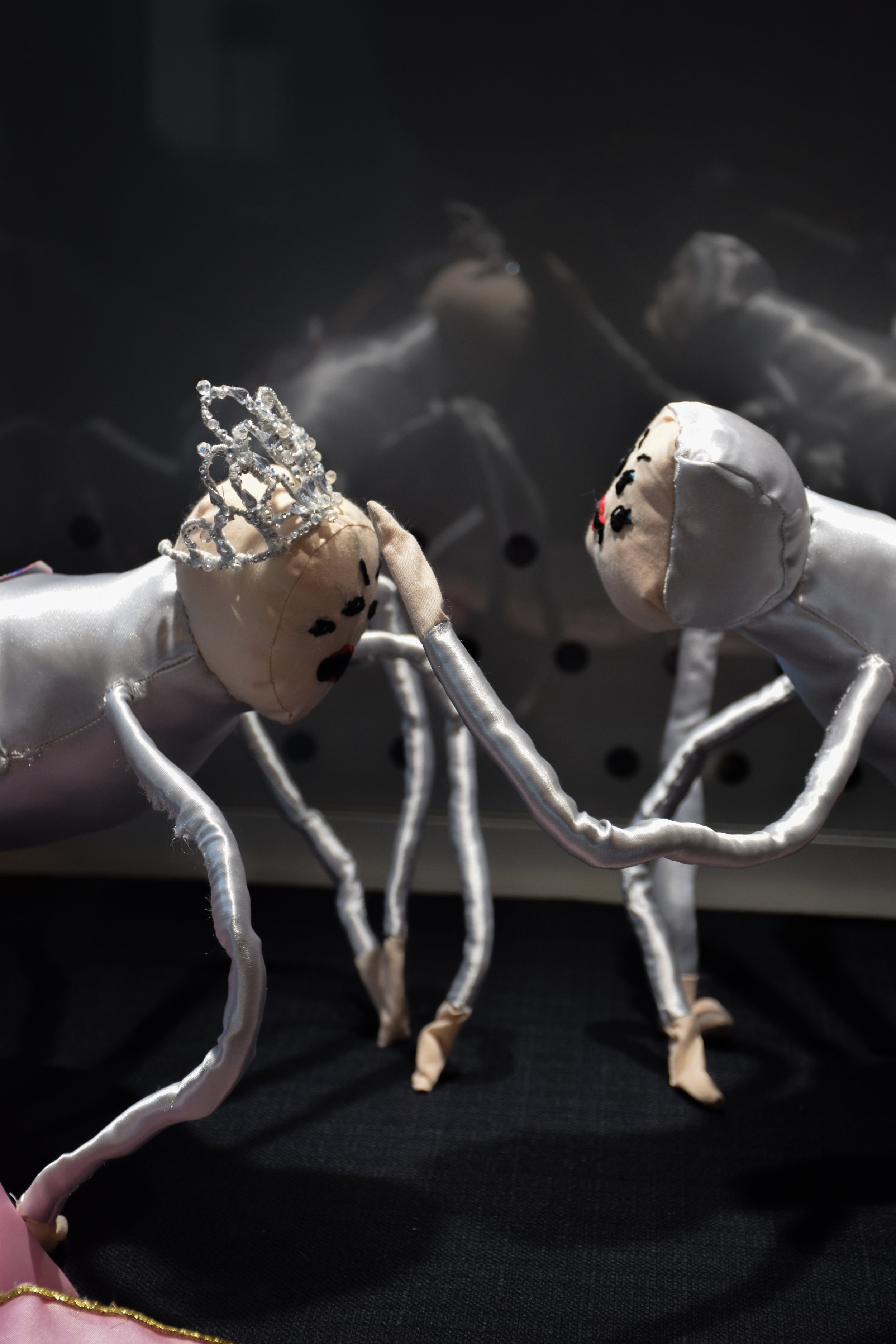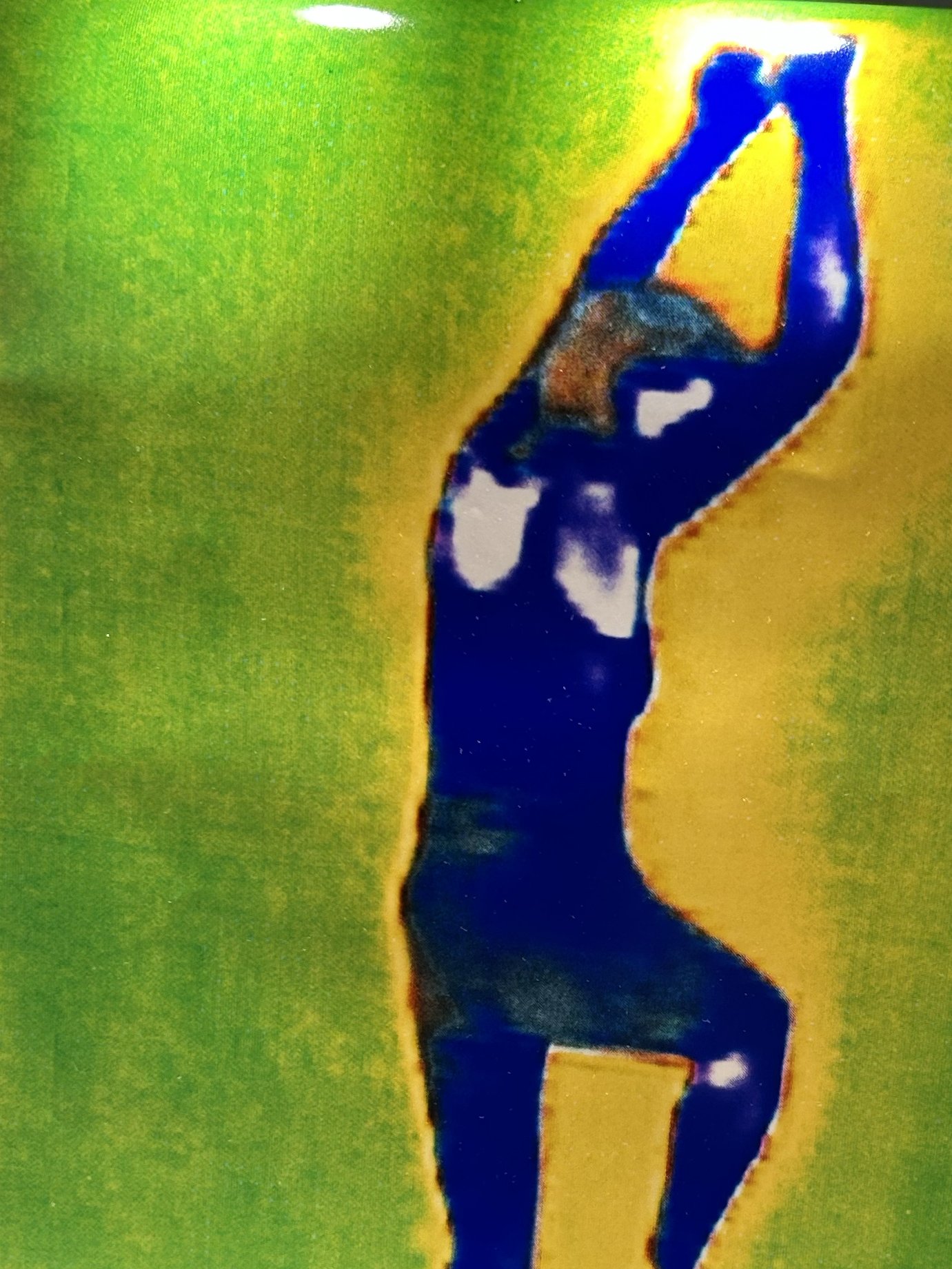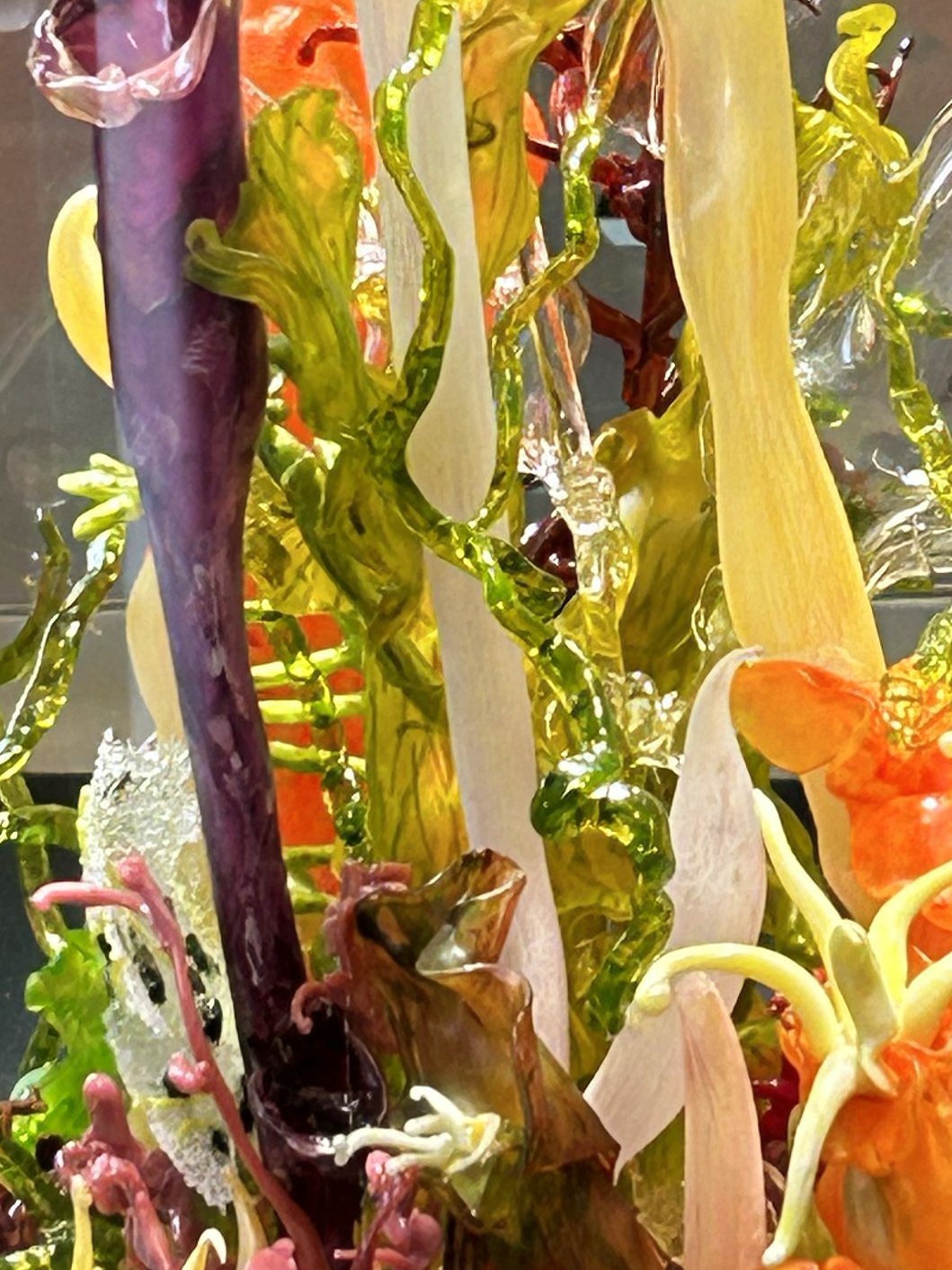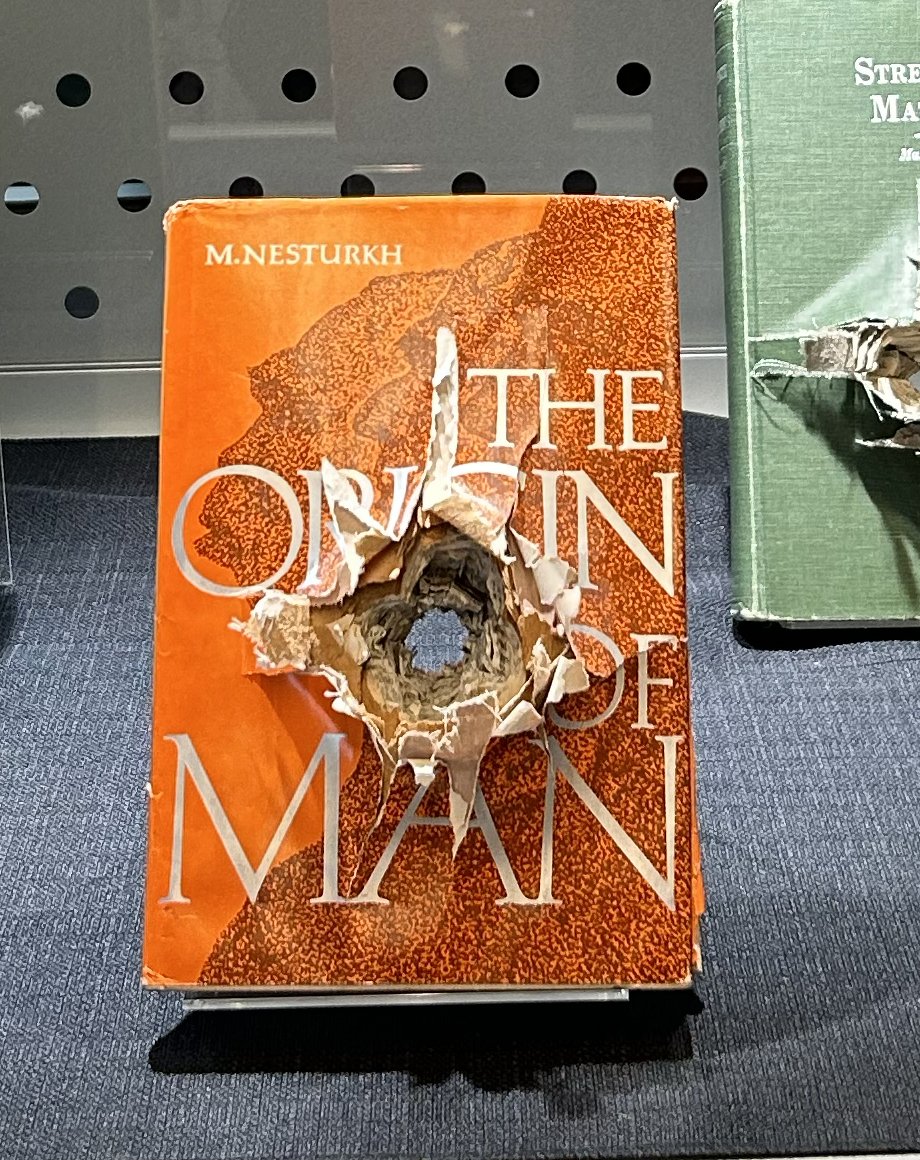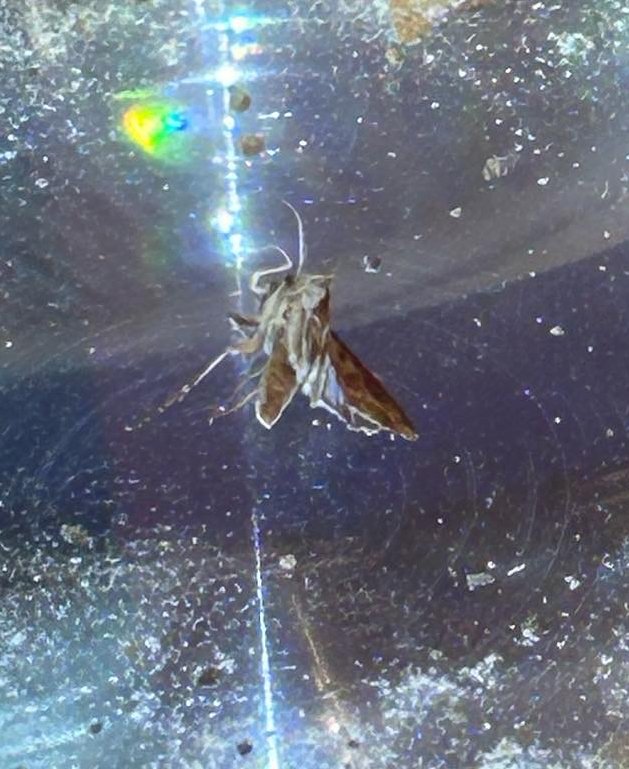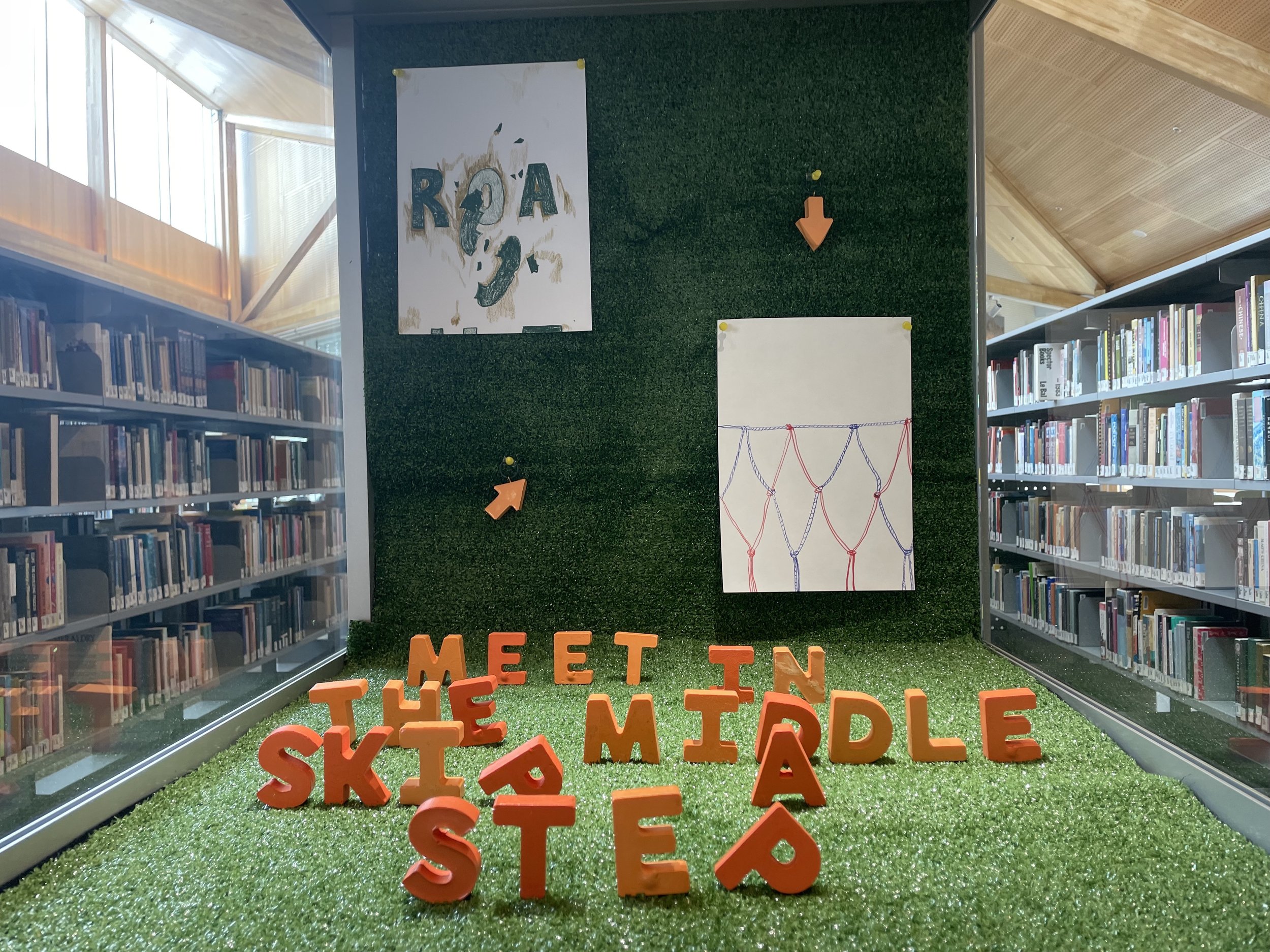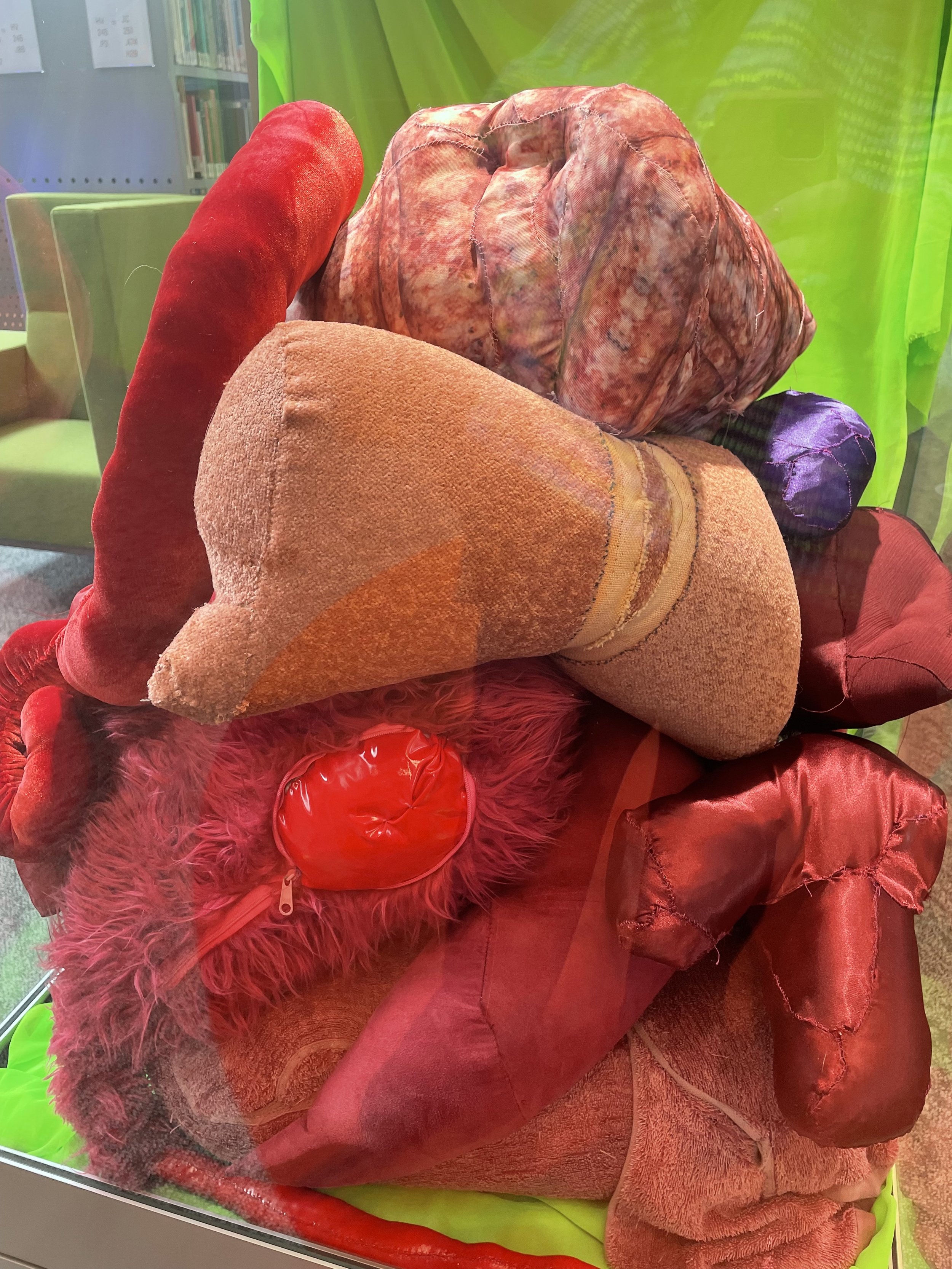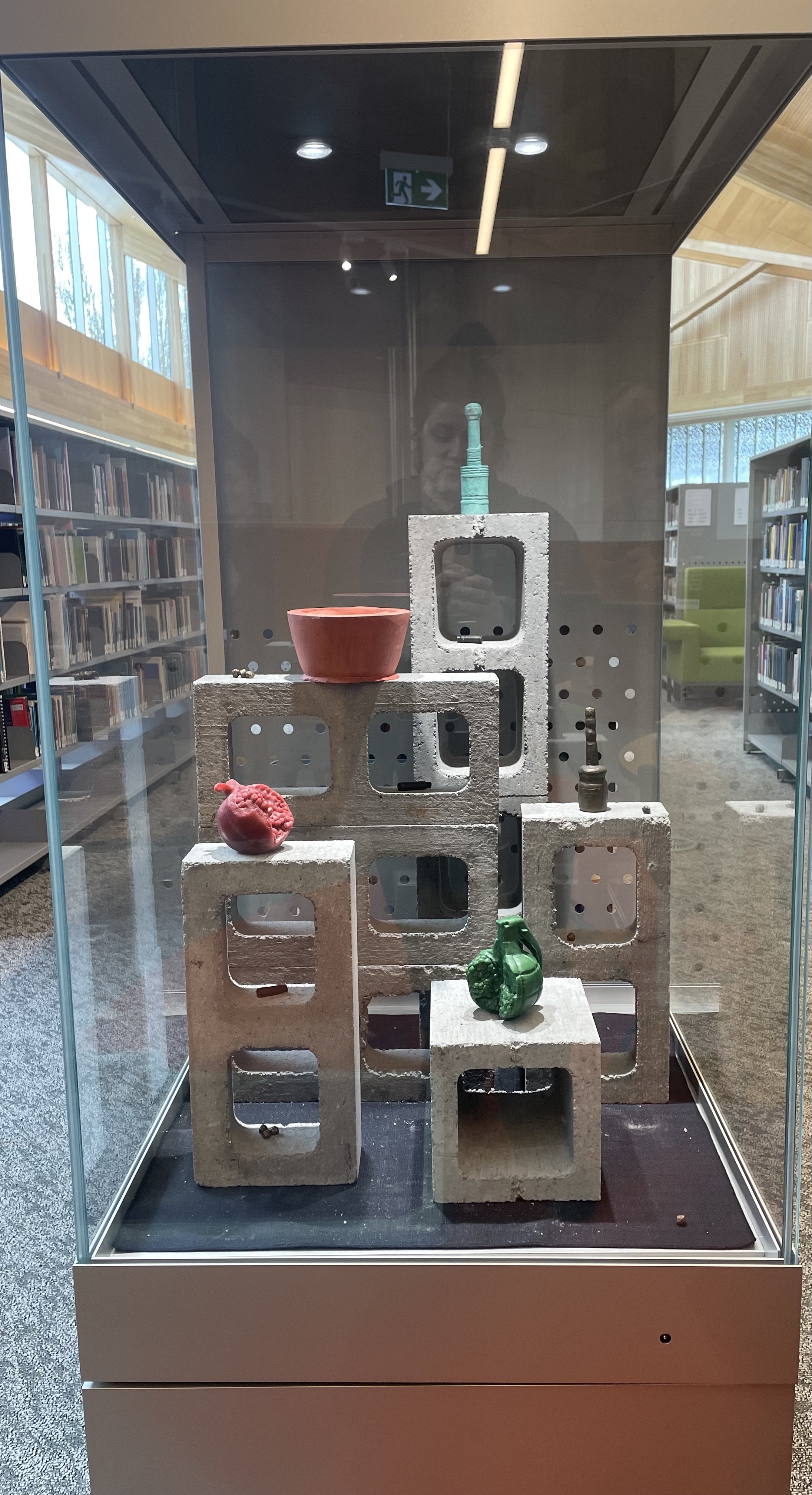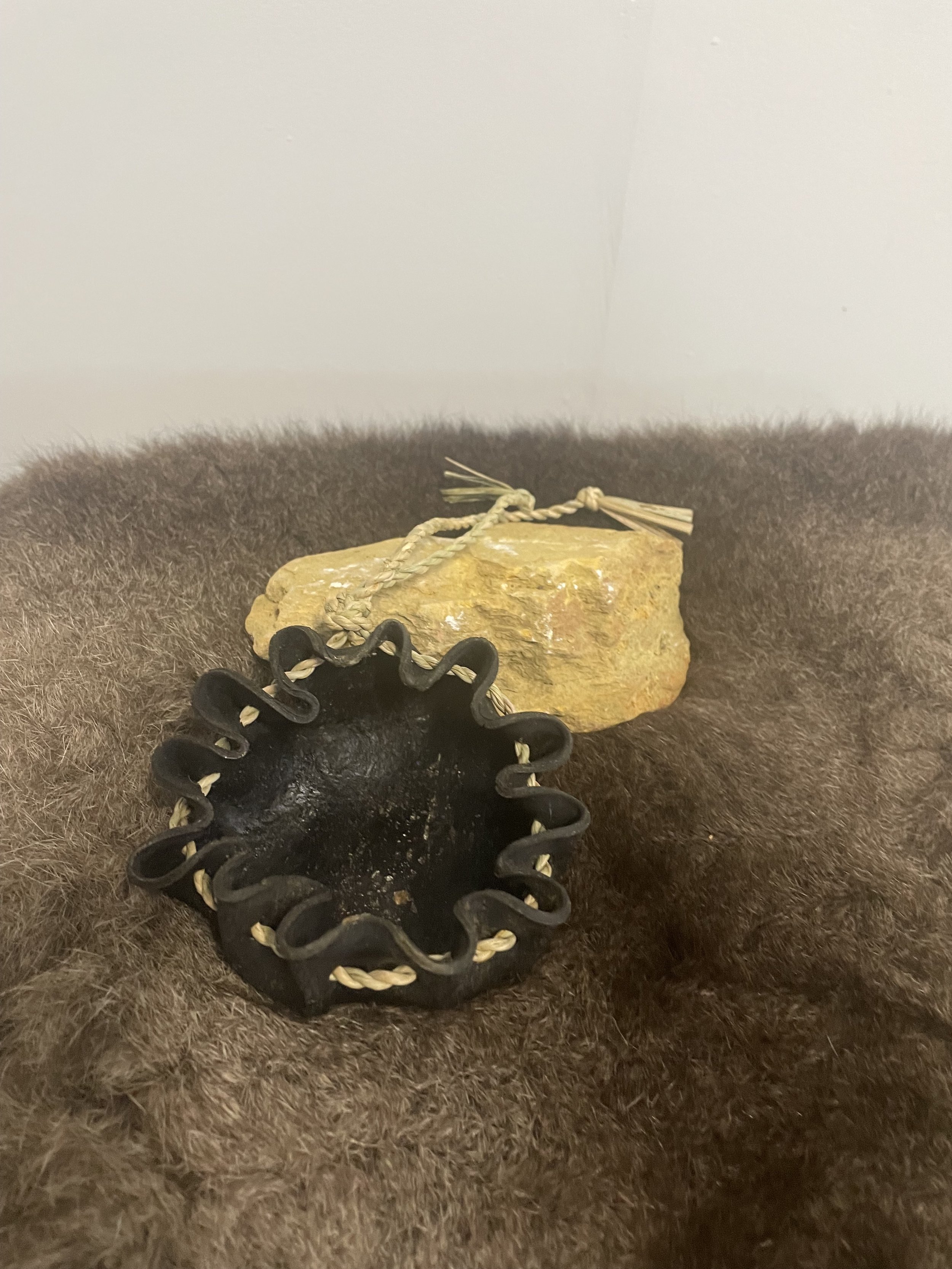The University of Tasmania x Sawtooth ARI
Currently showing at the University of Tasmania’s Inveresk Library (level three) are a series of vitrines that are curated by Sawtooth ARI director, Zara Sully. Every two months different artists are invited to reflect upon their practice and how it relates to the library’s theme of ‘Ways of Knowing.’
CURRENTLY EXHIBITING
Lucy Wilson & Chloe Catto
Top Image: Lucy Wilson, frictions, 2025, steel, enamel paint, mdf panel, dimensions vary (detail)
Bottom Image: Chloe Catto, (Anti)-Masterpiece, 2025, mixed media, dimensions vary (detail)
Chloe Catto
(Anti)-Masterpiece, 2025, mixed media, dimensions vary
Statement:
This work explores how objects and materials—both physical and ideological—are formed, reformed, and interconnected within systems of value that shape our relationship to material culture and progress. We face an ecological reckoning, as the planet can no longer sustain the relentless demands of a system that mines, produces, expands, and discards. By recontextualizing debased industrial detritus, I aim to highlight the latent autonomy and potential of the materials, positioning them in a constant negotiation between stability and collapse.
As the materials unravel from their previously assigned contexts, they emulate patterns of entropy—aggregating, fusing, and mutating into hybrid forms.
Sculpture becomes a means to metaphorically dismantle, decelerate, and liberate matter from modernist ideologies of progress and efficiency. As Richard Flood writes in Unmonumental: Objects of the 21st Century, “Our time demands the anti- masterpiece, things that are cobbled together. Stubby, brutish forms that know something of the world in which they are made to tell a contemporary story” (Flood, 2007, p. 13).
Flood, R. (2007). Not about Mel Gibson. In R. Flood, L. Hoptman, & M. Gioni (Eds.), Unmonumental: The object in the 21st century, 10–13. Phaidon Press Limited.
Biography
Chloe Catto is an emerging artist based in Nipaluna/Hobart, working across sculpture, installation, ceramics, and printmaking. Her practice engages with the urban environment and systems of control, exploring themes of material agency, precarity, and entropy. Through quasi-architectural and bodily forms, she examines the entangled relationships between built structures, human bodies, and their surroundings, evoking processes of transformation and dissolution.
Lucy Wilson
frictions, 2025, steel, enamel paint, mdf panel, dimensions vary
I am interested in the uncertainty of subjective experience and the instability implicit in everyday modes of representation. Working with familiar, ready-made materials, my work engages failure, humour and the anticipatory as means for creating moments of slippage and revealing the constructive potential of indeterminacy and not knowing.
Biography
Lucy Wilson lives and works on Wurundjeri land in
Naarm / Australia.
PREVIOUS VITRINES
Ways of Knowing- Empathy
Rebecca Selleck & Gabbee Stolp
Rebecca Selleck
Remnants, 2024 (top image)
Bronze, steel, cotton velvet, sealant
Dimensions variable
This work is assembled from remnants around my studio and comes from a quiet place in my mind. Sometimes words seem pointless when we’ve been shouting so loud.
Circles are calming, making orbits like atoms and stars and those thoughts trying to make sense of it all. Velvet is lush and embracing, pink like flesh and blue like waves. Bronze is an exploration of value systems, fragility, and permanence. Pteridium esculentum, or austral bracken, whose genus is prehistoric and expansive, shades the curled forms of the mice my cat once left me. A muscle shell splits and moves with the current, eroding with its surroundings and growing with the organisms that make it home. On a hovering twig lichen forms a complex symbiosis of cyanobacteria and fungi, along with a single-cell yeast and other friends. A little banksia pod rests with its leaf, having spat its seeds along the path we walk to school.
The vitrine holds them in stillness, pausing time.
This work is a small solace, a way to sit silently with the fragility and beauty of things when our voices grow weary.
Biography
Rebecca Selleck is a Canberra-based artist with a focus on sculpture and interactive installation, blending furniture, casting, assemblage, soft sculpture and animatronics. She completed her Bachelor of Visual Arts at the ANU School of Art with First Class Honours, majoring in Sculpture and Art Theory, and also holds a Bachelor of Communications, majoring in Creative Writing and Literary Studies. She uses her practice to reciprocally investigate and challenge her own perceptions within a culture of conflicting truths. Her work overlays time and place to express the need for human accountability and the painful complexities of animal and environmental ethics in Australia.
Gabbee Stolp
Maugean skate, 2024, goatskin leather, thread, natural pearls, onyx beads, stuffing materials (top image)
(Self Portrait as a) Tasmanian (Atlantic) salmon, 2022, lambskin leather, thread, natural pearls, stuffing materials
Soft shelled (clam), 2023, clam shell, lambskin leather, velvet, thread
Dear Thylacine of The Sea,
In 100 years, will they use your image on government letterheads and beer bottles and in tourism advertising campaigns?
Will there be Facebook groups dedicated to sharing sketchy videos of sightings of you in the Adelaide Hills?
Will tiny versions of you be forever trapped inside snow globes and sold at every newsagent, post office and country service station in the state?
Will Chris Hemsworth’s grandchildren chuck some of their excess cash at a project to bring you back from extinction?
I hope that’s not your fate.
Love,
Gabbee
Biography
Gabbee Stolp is a visual artist based in the Derwent Valley, lutruwita/Tasmania.
Gabbee’s practice exists across several mediums with a primary focus on contemporary jewellery, object-making and textiles. Gabbee’s work examines material, memory and place, evoking biological and metaphysical themes including grief, loss and human-induced extinction. Gabbee creates gentle tools with which to reflect on time and change and the way our human lives are invariably connected to the deep history and ecology of the places we live.
Ways of Knowing- Spirit
Katherine Barnes & Adelphie He
Katherine Barnes
Kappa and the Shadow I Cast(e) (left image)
Kappa is the river child of Japanese mythology, who brings knowledge of bones to humans to redeem his underworld devilish acts. It has a cradle in its head to bring water to those in need. The Ninja turtle origins.
Like Kappa’s story a half caste walks between two identities in cultures of extremes, where identity is an unknown conflict between the outsider and the newness of dawn, each day. Unlike one battle to be won, it is a cultural shift of incremental days where misdirection’s are a purposeful act. Racism with its shapeshifting between public and vigilante politics. The narrative misunderstood or misconstrued where religion is pontificating the weightiness of power.
In the C20th child psyche, is the institutionalised child of education after WW2, balancing and playing and being measured, memorising the structure of bones in the human conquest against the shadows of a separate reality. East and West. The rhizome of change and transparency gives rise to a C21st emotional intellect in the combined arts.
Adelphie He
Adelphie’s last meal with Froggie (right image)
I often find myself wondering about the end. Then I think, what would my tummy want to savour if tomorrow never arrives? This artwork of mine is a cloud of thoughts about my last supper - foods that make me giggle, foods that make me miss mama, foods that wrap me like a cosy blanket. I think at the end of the day, I would want to immerse myself in these feelings.
The friend I will have dinner with: Froggie
I made a little mochi grave for myself as my entree. I did a little cremation ceremony by burning my hair and burying it inside the mochi tower.
Yummy mochi balls with honey drizzled on top with soybean and matcha powder. A little bit of salt sprinkled like stars that balances the sweetness! I love mochi forever!
The main course is my memory lane.
I’d love to have some Chungfan that I so often dream of even across the oceans in Lutruwita/Tasmania. It’s rice flour steamed into sheets, then simply rolled and drizzled with Zhenjiang special soy sauce, speckled with sesame and a dash of chilli.
Next, it’s time for mama’s herbal soup with mushrooms dancing and bubbling inside. To prepare this soup, my mum would spend hours ensuring that all the ingredients are melded harmoniously; the broth is very nutritious and wholesome, like a warm blanket.
The final main course would be the taste of my grandpa’s chicken drumstick that he gave away that time. This fond memory recalls a summer holiday visit to my grandparents’ house when I was in first grade. As a token of grandpa’s love and kindness, and in keeping with Cantonese culture, he cooked one of his chickens for us when we visited. As children, we were treated to the drumsticks and wings—an extra special treat. At that time, a beggar appeared on our doorstep and asked if we could spare him some food. Grandpa immediately fill up a whole bowl with rice, veggies and topped it off with a huge drumstick to offer to the person. This memory of grandpa and his chicken rice and his generosity has greatly influenced the person I’ve become today.
For dessert, I’d delight in my all-time favourite—chocolate koala biscuits—plus some candy my friend Yumemi brought back from Japan. Munching on these sweets would rekindle memories with my friends, full of giggles, secrets, and playful fights.
Knowing that I have been showered with so many beautiful memories will dilute my fears of saying goodbye.
My beverage of choice would be something humble; red bean soup serve in a wine glass. In Chinese culture, red beans symbolize memory and longing, and it seems fitting to drink this symbolic wine as I bid farewell to life.
Teeeeheeeee :)
Adelphie
Ways of Knowing- Vulnerability, Authenticity, Sensuality
Benjamin Baker & Molly Turner
Benjamin Baker
a weed by any other name (left image)
a weed by any other name is a collection of objects and paintings situated around the subject matter of Dandelions. For me, a dandelion represents resilience in the face of capital progress. I relate it closely to my experiences of fringe dwelling as a queer person, as a person with a disability and as an artist in general. I see dandelions every day as I walk the streets, peruse my garden and look through my mountains of found imagery I use in the studio. They are this essential plant where all parts are useful, yet no parts are often made use of. By using these wonderful plants (frequently framed as weeds, excess, unnecessary) I can expand their meanings into my practice as symbols of resistance, nurture and the notorious 'other'. There is something so beautiful about a crack dweller, something that can thrive, grow, and then take on to the wind and start again. I hope to be more responsive to my surroundings like a dandelion.
Molly Turner
the good bad and ugly doll (right image)
Being an artist allows me to show an extension of myself that perhaps isn't "the vibe" or acceptable in public. It makes me feel a bit naughty.
Nobody wants to take you out for coffee to hear how many times you've sh*t the bed; they only want to hear how many times you've f****d on it.
Within this project I took the opportunity to have fun stitching, and sharing some of my most bashful moments. As a person and an artist, will happily air my dirty laundry to you.
Ways of Knowing- Tracing Place
Emmalyn Hawthorne & Lex Palmer Bull
Emmalyn Hawthorne
Astrolabe: minuter (left image)
In her recent body of work, Astrolabe, Emmalyn has been using Optical Character Recognition software to ‘read’ skylines and 3D printing to model the output. The software interprets the skyline as though it were handwriting, comparing the curves and angles to its database of written text. Sometimes just jumbles of letters and punctuation come out and other times whole words or phrases. For Inveresk Library, Emmalyn has engaged with the view from level three, installing the resulting sculpture in alignment with the skyline that generated it.
Emmalyn finds skylines and words are similar in that the way we perceive them depends upon our own positioning within physical and cognitive landscapes. Always in flux, they evolve and morph as we continue to interact with them over time. 3D printing then gives form to these histories — its layering of a thin line of filament across a surface not dissimilar to stacking pages and pages of writing. An astrolabe is a hand-held astronomical instrument, sometimes regarded as a rudimentary analogue computer, used for reckoning time and making measurements that enable the user to orientate themselves both on Earth and within the celestial sphere. This work offers a similar means of orientation and understanding, charting lines back through times, perspectives, and our, frequently destructive, use of the landscape and of words.
Lex Palmer Bull
Making Space (Right Image)
This artwork is an exploration of spatial dynamics through a material-led approach. Through the interplay of line, shape, and form, the work traces and maps the space it inhabits. Guided by the inherent qualities of the chosen materials, the artwork unfolds such that each material dictates the unfolding visual landscape through a process of tracing and mapping the space it inhabits.
Central in this work are the chosen materials: yellow trace, a familiar medium often employed in plan making, and unfired clay. The decision to leave the clay unfired imbues the artwork with a sense of vulnerability and impermanence. Unlike fired clay, which undergoes a transformation into a durable state, unfired clay remains in a state of flux, susceptible to external influences such as temperature, humidity and impact. This inherent fragility invites contemplation on the transient nature and temporality of shifting environments, while underpinning the conceptual framework of the work.
The clay shapes within the installation were not meticulously planned but rather formed instinctually, guided by an intuitive act of making in response to the physicality of the clay. The rough, imprinted textures were born from the act of pressing the forms into concrete bricks that once served as the foundation of a previous artwork. In this sense, this textural component acts as a visual injection of previous materials, akin to a mother used to ferment a new iteration; a building evolving from an existing foundation.
Through this marriage of materials and techniques, the installation invites viewers to contemplate the symbiotic relationship between creation and evolution, where materials predicate the curation of a space.
Ways of Knowing- Textiles
Mae Finlayson & Nicole O'Loughlin.
Ways of Knowing- Humour
Robert O'Connor & Penny Walker-Keefe
Robert O’Connor
Sister Wendy has a posse (left image)
Sister Wendy Beckett was hilarious insofar as a buck-toothed nun who got visibly horny over artworks and hosted her own television series can be.
Sister Wendy didn’t think much of Renoir. Nor Dali. Neither do I and that’s why I love her. She had no sex ever, just looked at art and prayed. She really was just like us. She had no social life and she was once heard on Desert Island Discs saying that she takes a “spectator's delight” in other people but doesn’t really hang out with them.
In 2018 after years of looking at art, praying three times a day, having exactly zero friends, and no sex at all, all for some unseen higher power, Sister Wendy died.
And that’s it – that’s the joke. The laughs on us.
Penny Walker-Keefe
Arabella and Anita Fight for the Title (right image)
In 1973 NASA launched the world’s first space station, Skylab. Two spiders named Arabella and Anita were taken aboard the space station as a science experiment to test their web-spinning abilities in space.
The spiders spent two months living in space. At first, they were disoriented, but in just two days they adjusted to low-gravity and began to spin webs. They died onboard Skylab, but their bodies were brought back to earth for study, and now reside in American museums.
After only two missions, the space station was left to gradually decay and in 1979 it entered the Earth’s atmosphere, breaking up and crashing over southern Western Australia. In an absurd union of events, a piece of the Skylab wreckage was driven from Esperance and presented on stage at the Miss Universe beauty contest, taking place in Perth that same week.
This artwork presents an alternative ending to the lives of these two spider astronauts; tired from years of hard work maintaining a space station, they coordinated a controlled crash, hitched a ride to Perth as stowaways in space debris, and entered a beauty pageant.
Ways of Knowing- Process
Kiah Pullens & Helene Boyer
Kiah Pullens
Flir3428_the making of the pleasure was all mine (left image)
Flir3428_the making of the pleasure was all mine is a new work developed for the collaboration between Sawtooth Gallery and Utas by Kiah Pullens.
Pullens’ residency at a photographic lab in Berlin 2022, exposed the often intimate workings of inside the darkroom, using a heat sensitive camera to capture the body as it emanates heat while focused and sometimes stressed.
From video recording to digital negative to hand printed analogue photograph, the work Flir3428_the making of the pleasure was all mine has been treated through a series of repetitive studio processes. The audience is provided intimate access to an unknown space, to a curated performance of dance in the dark, to a collaboration between artist and machine. This collaboration no longer just exists in the dark, and now contributes to the archive.
Helene Boyer
A Matter of Degree / Now you see it, now you don’t (right image)
A Matter of Degree (front sculpture) asks us to consider the degree of future environmental loss from increased sea surface warming. Tasmania’s marine habitats, some of the most biologically diverse in the world, are especially impacted; cold water loving Giant Kelp Forests have disappeared (they are the transparent ‘ghosts’ in this work). Unique kelp-covered reefs, colourful sponge gardens, soft corals, anemone and algae varieties are at risk. Similar past lost botanical bounty is now seen only ‘under glass’ in academic collections.
Now you see it, now you don’t (suspended sculpture). Created for this installation, I wanted to enable you to see the different ways that glass can transmit light and capture colour, depending on how it is treated after flamework. I also wished to exploit the emotional potential of the material by encapsulating a number of different surface finishes in a ‘nature story’ that suggests more than a seasonal lessening.
Ways of Knowing - Reflecting the Institution
Damien Melchiori & Marguerite Carson
Damien Melchiori
SYMBOLIC<>RUPTURE [SARCOPHAGIC DISPLAY]
Consider the exchanges and flows of power operating behind the scenes in the structuring of what we define as Knowledge; violent structures, theatres of the language-based symbolic order that historical narratives of progress attempt to maintain dominance within. In our present time, the popular concept of Knowledge appears to be inextricably tethered to the lingering traces of a project from the past, a project that attempted absolute taxonomical categorisation and evaluation of nature, regardless of the cost. Perhaps the proposed achievements of the Enlightenment project could be reconsidered in the presence of our contemporary geopolitical disparities and looming ecological disasters.
Could we experience positive, productive potentials by reframing familiar considerations of binary oppositions such as: Knowledge/Non-knowledge? And could we therefore locate other ways of knowing – after all, knowledge does not necessarily illuminate the shadows of superstition; rather the light of knowledge might result in the casting of new shadows, and by extension, new knowledge. In a polemic turn from traditional western techno-scientific ways of knowing, contemporary art could embrace unorthodox strategies for approaching new communicative forms, and transmit new intuitive and embodied knowledges for the present and beyond.
My practice explores mutually informing relationships between processes of creation and destruction in artistic production. Drawing upon a range of historical understandings of cultural-material production, it explores how complex socially constructed systems of influence and contestation productively interact in works of art. Of particular interest are works of art created through methods of radical material or contextual alteration, mutation, erasure, or destruction.
To qualify an action as creative or destructive is ultimately tenuous and culturally relative, for one person’s iconophilia might be another’s iconoclasm. My practice harnesses potentials for new communication through contradiction with a view to better understanding ways to creatively utilise the tensions and frictions found in contradiction. Ambiguity is central to my practice and as such, interpretation is multiple, narratives are able to be mixed and remixed, and the location of the art object is in a constant state of flux.
Speculating and generalising upon the history and identity of any given artwork can assume many forms and can lead to strange “eureka” moments. I refer to this speculation as “epistemic apophenia”—a neologism suggesting that new knowledge could be revealed through misinterpretations or cavalier syntheses of existing knowledges. It implies an uncertain relationship between knowing and not knowing. A suggestion is that proceeding with limited or incorrect knowledge, synthesising supposedly incompatible knowledges, and forming patterns at random could result in positive and productive potentials.
Informed by a longstanding interest in productive tensions produced through opposing forces—such as noise and silence, order and disorder, or the institution and the “underground”—my practice seeks a conceptual framework for better understanding the ways in which opposing forces are necessary parts of the same cycles of constant change. I do not as consider these oppositionalities as simple binaries or dichotomies but rather as dynamic relationships which are complex, multifaceted, and multidirectional, and seeks to identify moments of rupture caused by tensions and conflicts in the overlays of opposites.
Marguerite Carson
Mothlight (right image)
The history of the vitrine is a charged one; rooted in Victorian obsession with collecting, display and preservation. Tied inextricably to the extractive nature of knowledge, its classification, and the church’s elevation of relic-objects from the un-remarkable to the realms of the precious and powerful.mIn art the vitrine is an uncomfortable space, a barrier or isolation chamber for sculpture, a separation from the embodied and visceral nature of the object.
Existing in this discomfort Mothlight explores the vitrine as site, a place where time stops, doesn’t move, air flow ceases, circulation slows, nothing is breathing. Sealed behind glass there is an interiority, filled with a muffled and inflexible temporality. Vitrines flatten time or remove it, disallowing it to take its course, actively battling decay. This is a work that is about looking, about the gaze, about the power of the institution to freeze something and to display it, mute. To display, as if to splay, as if to pin open and vulnerable permanently. To render without air and therefore without life. The vitrine is a killing.
A projection is a transmutation [of form to image] thrown to wherever it lands. The work enacts a double looking, through the glass pane of the vitrine and the glass lens of the projector, creating an image which is ripped from the (di)splayed moth lying amid its dust. Dust - the ghost of industry, sourced from Triabunna and the now renovated wood chip mill which at its peak was the largest in the world. In its removal from form the image becomes surface-less, liquid and etherial. Cast in the light from beneath, focussed by the Fresnel lens on which it lies the moth finds new life in its familiar, a mirroring takes place as the image flips not once [through the lens] but twice as the mirror in the projector which would usually allow script to be read right-way-round on such a projection, has been removed.
A projection is an extension, a protrusion into space, seeking escape. The moth lives again as the most simple of indexical marks, an inscription or figure that forms the building blocks of writing and the smallest constituent part of a typeface; a glyph. The image enacts its escape not in the throw of the projected but in another transmutation, into writing and out of the realm of the visual - into the spoken. Only in the voice can the moth and its image, its familiars, escape the trapping glass and the pinning gaze. Freed from the scene.
Ways of Knowing- Queer
Emma Berry + Liv Moriarty & Olly Read
Emma Berry + Liv Moriarty
driving backwards on a one way street (left image)
We learn the world through mistakes, we backtrack, apologise, we stutter. We convene in the middle to retrace our steps. We miss a turn and veer off the path. driving backwards on a one way street, is self referential to the way in which we operate and move through the world. We amalgamate experiences, conversation, trains-of-thought and interpretation to see where we land. We lean into our clumsiness and allow ourselves to blunder.
Olly Read
The Exquisite Corpse of a Self-made Man (right image)
Olly Read (Impious Monk) is an emerging artist from north-west lutruwita (Tasmania). Their creative output derives from an obsession and preoccupation with the body stemming from their experiences being transgender. They are particularly interested in the manipulation of mundane materials to highlight the alien nature of the seemingly familiar. Olly’s work is multi-media in nature; incorporating textiles, stop-motion animation, video projection, sound design, photography, collage, and more. After 6 years of study, Olly has emerged from the studios of the University of Tasmania’s Inveresk campus with a distinct and clear artistic voice, as well as a Master of Fine Arts in 2022 and a Bachelor of Contemporary Art with First-Class Honours in 2019.
Ways of Knowing - Cultural
Lara Chamas & Bianca Templar
Lara Chamas
Mortars and Pestles (left image)
Lara Chamas is a Lebanese, Australian artist, based in Naarm (Melbourne), fleeing from civil war, her parents migrated to Australia, where she was born. Her practice investigates topics of postcolonial and migrant narratives within the context of her cultural identity. Using narrative and experience documentation, storytelling, transgenerational trauma and memory and tacit knowledge; her research intends to explore links and meeting points between narrative theory, cultural practice, current political and societal tensions, and the body as a political vessel. Central to her practice is the expansion of these notions in a more historical and anthropological sense. With discussing geopolitical issues, research and first-hand experience is important to the authenticity of her work.
Bianca Templar
Takamuna rrala (stand strong) (right image)
Takamuna rrala (stand strong) is a showcase of Palawa culture through the eyes of one of its community members, Bianca Templar. Takamuna rrala showcases a variety of different aspects of palawa/pakana culture, from the more traditional practices of shell stringing and basket making, to the contemporary aspects of painting (utilising the Tasmanian Aboriginal Petroglphs) and resin art. Takamuna rrala is not only showcases the passing of cultural knowledge through generations, but to show the ongoing strength of the palawa/pakana people who have continued to strive despite the ongoing effects colonisation has had.










